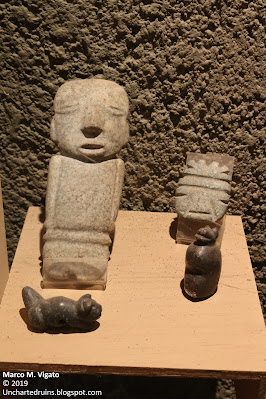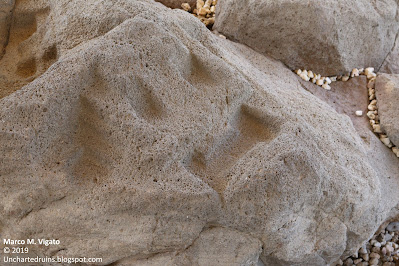A small site in the southern part of the state of Mexico, virtually unknown until it was only partially excavated in the early 1990’s, may hold the evidence of an unknown civilization that flourished at the same time as the mysterious Olmecs and left some incredible stone monuments that have no equals in other parts of Mexico and Mesoamerica.
The small archaeological site of San Miguel Ixtapan is located in the south of the State of Mexico, at the entrance of the Tierra Caliente region that from the highlands of Central Mexico leads down to the Pacific coast. One gets there from the city of Toluca on highway 134 after passing the town of Tejupilco de Hidalgo, or from the popular lake resort town of Valle de Bravo, from which it is only about 70 kilometers (45 miles) distant.
 |
| The enigmatic Cerro de la Muñeca, dominating the site of San Miguel Ixtapan from the distance and the subject of many curious legends and local traditions. [Photo by Author] |
The site is only one of a handful that has been at
least partially explored in the southwestern part of the State of Mexico, an
otherwise blank spot on the archaeological map of Mexico. Its discovery only
dates to 1985, when a huge sculptured “maqueta”
model stone was uncovered by farmers plowing a field near the local cemetery. It
was not until 1995 that a small portion of the site, including parts of a large
pyramid and a Mesoamerican ball court – only one of three known in this part of
Mexico – were excavated.
 |
| A view of the 40-meter long ballgame court of San Miguel Ixtapan, one of only three known in the State of Mexico. [Photo by Author]. |
 |
| A panoramic view of the excavated portion of the site of San Miguel Ixtapan from a nearby unexcavated pyramid mound known as “El Calvario”. [Photo by Author]. |
The earliest traces of human occupation in the area date back at least 12,000 years, in the form of cave paintings in the nearby Sierra de Nanchititla. An unknown culture then occupied the site around 2,000 BCE. To this remote period dates a human burial found on top of a still unexcavated pyramid mound or platform, which contained a mosaic stone mask, another smaller mask made of jadeite with Olmecoid features, and a jade beads necklace, together with human remains that provided a chronological reference date for the burial (Sinaí Gomez, 2012).Since the time of the site’s discovery, several subsequent excavation campaigns have revealed at least five different periods of occupation of the site during the Formative, Pre-Classic, Classic, Epi-Classic and Post-Classic period.
 |
| A detail of the small Olmecoid (?) green stone mask associated with the offering. [Photo by Author] |
 |
| Mezcala culture (700 BCE - 650 CE) stone figurines from the Site Museum of san Miguel Ixtapan. [Photo by Author] |
Several Formative period ceramic figurines were also
found, dating to between 800 and 200 BCE, showing affinities with the Tlapacoya
and Tlatilco artistic tradition of Central Mexico. The discovery of a number of
Teotihuacan style artefacts further testify to the site’s occupation during the
Classic period, when it either came under direct political control or was
influenced by Teotihuacan. After the fall of Teotihuacan, in what is known as
the Epi-Classic period (750-900 AD), the site knew its greatest expansion, with
the construction of several monumental structures and pyramids rivaling in size
other nearby sites like Teotenango and Xochicalco.
After a period of abandonment, the site was then
reoccupied by the Aztecs in the Post-Classic period, and remained inhabited until
the time of the Spanish conquest.
The site nowadays consists of a large pyramidal
platform with a temple and smaller rooms on top in which several sculptures
were found, a Mesoamerican ball court, a monumental stairway built of large
basalt blocks, and a sunken courtyard. Some very notable sculptures were found
in niches and chambers of the main pyramid (also known as Basement 3),
including a large stela with a depiction of the rain god Tlaloc, and multiple
anthropomorphic figures with unusually crossed arms, a pose quite rare in
ancient Mexico and with possible funerary significance.
 |
A detail of some huge
basalt blocks that would have formed part of the monumental stairway. [Photo by
Author]. |
 |
| The shrine to Tlaloc, on one side of Basement 3, where the Tlaloc stela was found. [Photo by Author]. |
 |
A stela with an early
depiction of the god Tlaloc. [Photo by Author]. |
 |
A circular stone marker
found in the ballgame court of San Miguel Ixtapan and dating to the late
Epiclassic period (ca. 650-900 CE). [Photo by Author]. |
The site is also home to a small but very interesting site museum containing a wealth of objects found during the early 1990’s excavations, including ceramics, stone and jadeite ornaments, obsidian knives and points, copper and bronze artefacts (including a remarkable necklace with exquisitely worked human heads and figurines made of copper), as well as stone sculptures, votive offerings and a stone ring associated with the ballgame court. The artefacts show a remarkable range of trade interactions and a definite influence from the Mezcala culture of Guerrero and the Balsas river culture. The location of San Miguel Ixtapan was probably considered strategic on account of the presence of salt mines, still in use since prehispanic times, and of large deposits of columnar basalt providing readily available material for construction.
 |
Part of a megalithic
basalt wall and stone arrangement on the opposite site of the ravine from the
site museum of San Miguel Ixtapan. [Photo by Author]. |
 |
| Another view of the same basalt stone arrangement employing huge megalithic stone blocks. [Photo by Author] |
The incredible “Maqueta”
Stone model
The “Maqueta” stone is a huge carved basalt stone boulder, measuring
some 3 by 4 meters. It was this stone, uncovered by farmers plowing a field,
which first called archaeologists to the site in 1985. The huge stone is
entirely covered in miniature representations of architectural structures
believed to represent a city (whether real or imaginary is a matter of
speculation), complete with temples, pyramids, at least five ballgame courts,
plazas and sunken courtyards, all connected by avenues and stairways. Similar
examples of prehispanic architectural models are known to exist from
Xochicalco, Morelos; Plazuelas, Guanajuato; Valle de Bravo, Mexico (see our
recent article
and story here);
Teotihuacan (Mexico), as far as Tikal, Guatemala. Among these, the one of San
Miguel Ixtapan is possibly the largest and most complex, comparable to the
famous Sayhuite stone of Peru.
 |
| Another view of the same "Maqueta" stone, from the North. [Photo by Author] |
 |
| The "Maqueta" stone from the North, showing its left portion. [Photo by Author] |
 |
| The "Maqueta" stone from the North, showing its central portion. [Photo by Author] |
Several attempts have
been made to identify the site depicted on the stone, seemingly a hilltop
ceremonial center of exceptional scale and complexity, but these attempts have
so far proven entirely fruitless. It is possible that the stone portrays a yet
undiscovered site, perhaps located in the mountains to the north and east of
San Miguel Ixtapan, or that the city depicted was purely imaginary, a votive
representation of an idealized place or sanctuary. It may well be a city that
is still lost or the drawing of a city yet to be built.
 |
| A view of the "Maqueta" stone from the West [Photo by Author]. |
 |
| An interesting double pyramid approached by a monumental stairway and facing a small plaza. [Photo by Author]. |
 |
| A detail of the main pyramid complex occupying the center of the “Maqueta” stone with a sunken courtyard approached by monumentalized stairways on three sides. [Photo by Author]. |
 |
| Another sector of the monumental “Maqueta” stone depicting what appear to be various rock-cut chambers and stairways below the main pyramid complex. [Photo by Author]. |
 |
| The depiction of a pyramid approached by a monumental stairway facing a Mesoamerican ballgame court with the typical ‘I’ shape. [Photo by Author]. |
 |
| A detail of the sunken courtyard or plaza to the West of the main pyramid complex, approached by monumental stairways on three sides. [Photo by Author]. |
 |
| A view from the South and from above of the lower sector of the "Maqueta" stone, showing various groups of buildings. The main pyramid complex is above in the picture. [Photo by Author] |
 |
| A model temple sculptured on a separate piece of rock, from which it is possible to appreciate the stairway leading up to the temple and altar on top. [Photo by Author]. |
There are no definite
elements for dating the “Maqueta”
stone, but archaeologists mostly favor a date in the Epiclassic or early
Postclassic period (ca 900-1200 AD).
In the second part of this article we will be discussing some of the other evidence of high-precision megalithic architecture in San Miguel Ixtapan.
- CONTINUED IN PART II -
Acknowledgements
We would like to thank
archaeologist Victor Osorio Ogarrio, director of the site and archaeological
museum of San Miguel Ixtapan for his kind permission to visit the “Recinto de las Esculturas” and for
accompanying us on our visit to Rancho “I”.
The opinions expressed in
this article are solely the Author’s and do not necessarily reflect the
opinions and beliefs of Dr. Osorio, of the National Institute of Anthropology
and History (INAH), or of the Secretary of Culture of the State of Mexico.
References
[1] INAH, “Zona Arqueológica de San Miguel Ixtapan”,
on January 9, 2008. On-line resource:
https://www.inah.gob.mx/zonas/46-zona-arqueologica-de-san-miguel-ixtapan. Accessed
on April 20, 2021.
[2] Malmstrom, Vincent H. “Geographical Origins of the
Tarascans”. Geographical Review, vol.
85, No. 1, January 1995, pp. 31-40.
[3] Osorio Ogarrio,
Victor Ángel and Marco Antonio de León Cortés. “Una posible Diosa Prehispánica
en San Miguel Ixtapan, Tejupilco”, Arqueología
Mexicana, 158, July-August 2019, pp. 46-51.
[4] “Revista cultural
San Miguel Ixtapan”, Expresión Antropológica,
no. 1-2 Nueva Serie. Gobierno del Estado de México: Secretaría de Cultura,
1999.
[5] Reyna Robles, Rosa
María, La Cultura Arqueológica Mezcala,
Instituto Nacional de Antropología e Historia, 2006.
[6] “San Miguel Ixtapan, Estado de México”, Arqueología Mexicana, Especial 35, Estado
de México, guía arqueológica, June 2010.
[7] Sinaí Gomez,
Rodolfo, “Antecedentes Históricos - Tejupilco”, Municipio de Tejupilco, 2012. On-line
resource. Accessed on April 25, 2021 through Archive.org: https://web.archive.org/web/20120327194635/https://www.tejupilco.gob.mx/contenido/index.php?option=com_content&view=article&id=59&Itemid=59
[8] Wikipedia, “San
Miguel Ixtapan (Archaeological Site)”. Last edited on December 19, 2020.
On-line: https://en.wikipedia.org/wiki/San_Miguel_Ixtapan_(archaeological_site).
Accessed on April 20, 2021.












Marco thank you for this fascinating blog post. The burial artifacts are stunning.
ReplyDelete